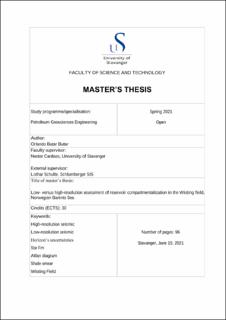| dc.description.abstract | Wisting is Norway’s northernmost oil field under development. With ~500 mmboe in shallow marine to fluvial Upper Triassic to Middle Jurassic reservoirs, which are highly faulted and just 250-300 m below sea bottom, this field is quite unique. Wisting sits between the Maud Basin and the Hoop fault complex and is characterized by an orthorhombic fault system consisting of WNW-ESE, NNE-SSW, NE-SW and N-S trending faults. Polygonal faults affect the Cretaceous shales above the reservoir interval. Since the reservoir units are very shallow and the lithology heavily faulted, evaluating fault sealing and the impact of fluid injection on fault reactivation are crucial for the safe, future development of the field. In this study, the seismic survey covers an area of 16km2 encompassing the Wisting field. Within this area, we use publicly available (via DISKOS) low- (10 to 70 Hz) and high- (7 to 185 Hz) resolution seismic data, to better understand the impact of seismic resolution on the interpretation, fault juxtaposition relationship, reservoir compartmentalization, and gross reservoir volume. The focus of this study is the Stø Fm which provides the main reservoir.
We integrate the information from one exploration well with gamma-ray, resistivity, sonic, density and neutron logs, as well as formation tops. Well interpretation and seismic-well tie are the two initial steps to identify the reservoir zone and link the well log signature to the seismic. The variance and RMS amplitude attributes are used to guide the fault interpretation and to identify hydrocarbon accumulation. Depth structure maps from the low- and high-resolution datasets are constructed, and their differences evaluated. Low- and high-resolution fault throw maps and juxtaposition (Allan) diagrams are also constructed, compared and analysed.
The high-resolution data image the fault zones with impressive detail (although there are fault shadow issues in the footwalls). The study clearly demonstrates that the high-resolution seismic provides essential information such as flat-spot, reservoir heterogeneity and shale smear that cannot be derived from the low resolution seismic. Moreover, the high-resolution model provides more details in the fault throw distribution and in the juxtaposition relationships of the Stø Fm. The top and bottom of this reservoir zone from the high-resolution seismic honours the well-tops and seismic reflectors, whereas this is not the case in the low-resolution seismic. As a result, the reservoir thickness map and the gross reservoir volume from the low-resolution model are more susceptible to uncertainty. The result of this study shows the critical gain in information of high resolution seismic and its impact on the accuracy of the reservoir determination. | |
